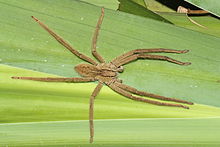Cupiennius
Appearance
| Cupiennius | |
|---|---|

| |
| C. salei, Adult Male, In Northern Honduras, by Stuart J. Longhorn. | |
| Scientific classification | |
| Domain: | Eukaryota |
| Kingdom: | Animalia |
| Phylum: | Arthropoda |
| Subphylum: | Chelicerata |
| Class: | Arachnida |
| Order: | Araneae |
| Infraorder: | Araneomorphae |
| Family: | Trechaleidae |
| Genus: | Cupiennius Simon, 1891 |
| Species | |
|
See text | |
| Diversity | |
| 11 species | |
Cupiennius is a genus of wandering spiders, known by the common name banana spiders,[1] found from Mexico to northwestern South America, and on some Caribbean islands. The genus includes both relatively small species where the cephalothorax is less than 9 mm (0.35 in) and large species where the cephalothorax can measure almost 40 mm (1.6 in).[2] The larger species are sometimes found far outside their native ranges in shipments of fruits, where they are frequently confused with Phoneutria spiders. However, unlike the dangerously venomous Phoneutria, bites from Cupiennius typically only have a minor effect on humans and have been compared to a bee sting.[2]
Species
- Cupiennius bimaculatus (Taczanowski, 1874) — Venezuela, Brazil, Guyana, Ecuador
- Cupiennius chiapanensis Medina, 2006 — Red-faced Banana Spider[1] — Mexico
- Cupiennius coccineus F. O. P.-Cambridge, 1901 — Red-legged Banana Spider[1] — Costa Rica, Panama
- Cupiennius cubae Strand, 1909 — Cuba, Costa Rica to Venezuela
- Cupiennius foliatus F. O. P.-Cambridge, 1901 — Costa Rica, Panama
- Cupiennius getazi Simon, 1891 — Spot-legged Banana Spider[1] — Costa Rica, Panama
- Cupiennius granadensis (Keyserling, 1877) — Costa Rica to Colombia
- Cupiennius remedius Barth & Cordes, 1998 — Guatemala
- Cupiennius salei (Keyserling, 1877) — Mexico, Central America, Hispaniola
- Cupiennius valentinei (Petrunkevitch, 1925) — Panama
- Cupiennius vodou Brescovit & Polotow, 2005 — Hispaniola
References
- ^ a b c d Vetter, R.S., R.L. Crawford, D. J. Buckle (2014) Spiders (Araneae) Found in Bananas and Other International Cargo Submitted to North American Arachnologists for Identification. Journal of Medical Entomology 51: 1136-1143
- ^ a b Vetter & Hillebrecht (2008). On distinguishing two often-misidentified genera (Cupiennius, Phoneutria) (Araneae: Ctenidae) of large spiders found in Central and South American cargo shipments. American Entomology 54: 82-87.
External links
Wikimedia Commons has media related to Cupiennius.
